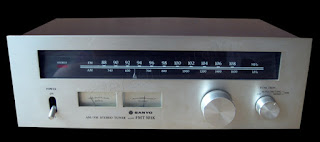NAD's
Compact Disc players are known for fine sound, superior tracking, powerful
error correction, and reliable construction. But the greatest differecnce
between NAD players and other is NAD's uniquely simple and logical approach to
design.
The NAD
5220 CD player is securely in this
no-frills, high-performance, best buy tradition. They were created for people
whose primary interesst is music, not gadgets. The theme of simplicity extends
to their analog output circuits as well; with only a handful of electronic
components in the signal path, their sound is particularly pure and clean.
This
player is eqquipped withh full-disc automatic repeat and programmable memory
playback of up to sixteen selections in any order. And both players include new
features of significant value to users. The economical NAD 5220 adds a Timer
Pay feature that autimatically plays a disc when the power is switched on. So,
by plugging the player's AC power cord
into a clock timer, you can provide your own choice of wake up music in
the morning instead of depending on a clock radio.
NAD 5220
employ a solid metal chassis for maximum stability, precise alignment, and
long-term reliability. The metal chassis provides electrical shielding to
reduce leakage of interference from the digital circuits into your phono preamp
or FM tuner. The playback mechanism floats on springs within, minimizing the
transmission of vibration to the spinning disc, ensuring secure tracking even
in the presence of the powerful vibrations produced by your loudspeakers.
The
output circuit in this player exemplifies the "less is better"
approach, with only a handful of electronic components in the signal path. The
elegantly simple analog stage has only one active circuit in each channel; a
high-speed filter that provides de-emphasis and removes unwanted ultrasonic
noise. To ensure that this active filter circuit cannot be overdriven into
transient distortion, the analog signal is pre-smoothed by a passive multipole
filter that is connected directly to the digital de-multi-plexer. High-quality
polypropylene capacitors are used at sonically critical points in the circuit,
e.g., in the treble de-emphasis network.
Specifications
Type: CD player with optical pickup
Quantization: 16-bit linear
Channels: 2 channels (stereo)
Frequency
Response: 5 Hz - 20 kHz ±0,5 dB
Dynamic
Range: 94 dB
Total
Harmonic Distortion: 0,004$ 91 kHz)
Channel
Separation: 90 dB
Wow and
Flutter: unmeasurable
Output: 2,0 V
Pickup: Semiconductor laser
Track
Search; by track number
Power
Consumption: 13 watts
Dimensions
(W x H x D): 340 x 57,5 x 309,5 mm
Weight: 2,9 kg






























